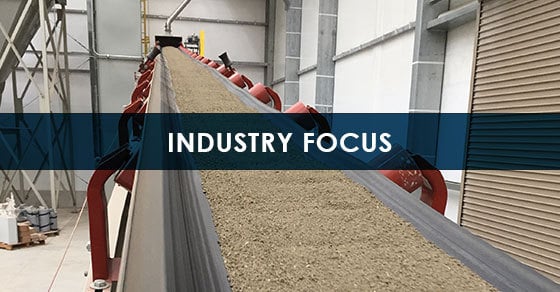From moving ore at the mine site, to storing finished product, the fertilizer industry relies on bulk material handling equipment to keep processes running and product moving around the clock. This heavy demand, combined with some of the specific challenges fertilizers present, requires expertly designed and fabricated equipment for optimal efficiency and long-term reliability.
Materials Handled
Between mine sites and production facilities, the fertilizer industry handles a range of different products and materials. This often includes:
- Minerals and ores such as potash, phosphate rock, and iron ore
- Inorganic materials such as urea and sulfur
- Organic materials such as manure, compost, and biosolids
- Complex fertilizers such as MAP, DAP, NPK
- Finished single nutrient products and blends
Common Bulk Material Handling Equipment in the Fertilizer Industry
Each and every handling situation is unique, requiring a customized bulk handling approach. However, these systems generally employ the same equipment in varying configurations in order to meet their specific needs. The most widely used types of bulk material handling equipment used for fertilizer are outlined here.
Bucket Elevators
Bucket elevators are the industry standard for vertical fertilizer handling. While they are capable of handling a wide range of materials, they are not typically recommended when handling wet, sticky materials such as manure.
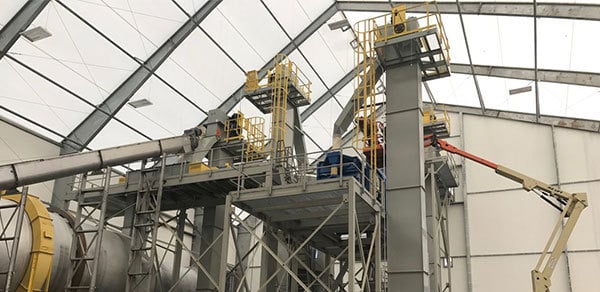
FEECO Bucket Elevators in an organic fertilizer plant
Bucket elevators are highly customizable and available in many different configurations to suit different vertical handling needs. Base options are centrifugal belt, centrifugal chain, continuous belt, and continuous chain.
Centrifugal belt-style elevators are favored in high-capacity settings that require moving large quantities of material quickly. At the mine site, centrifugal chain is often used as it allows for greater capacity and is more rugged than the belt style. For super high-capacity handling, a double chain configuration may be employed.
The continuous belt-style elevator, while still offering high capacity handling, promotes the more gentle handling commonly required by finished products. A range of bucket styles are available for a tailored approach.
Troughed Belt Conveyors
Troughed belt conveyors are the standard for horizontally moving materials from one point to another in almost every industry, and fertilizer is certainly no exception. Belt conveyors can handle up to 8,000 TPH and can be run up to an angle of 20° (when utilizing a troughed belt), or 30° with cleated/chevron belting.
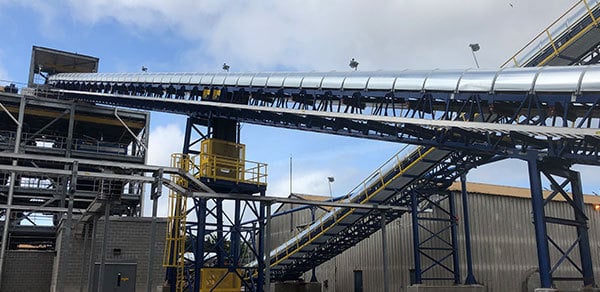
FEECO Troughed Belt Conveyors with weather covers
Troughed belt conveyors allow for high-capacity handling, while keeping material contained on the belt. Additionally, while screw conveyors offer an alternative handling solution, belt conveyors promote more gentle handling, helping to minimize attrition from handling, and can also accommodate a higher capacity than screw conveyors.
Conveyors can be provided with a wide range of accessories and customizations to increase efficiency. Weigh belts, or belt scales, are almost always employed to monitor mass flow.
Trippers & Plows
Both belt trippers and plows are commonly incorporated into fertilizer conveyor systems to improve flexibility, particularly when it comes to storing fertilizer.
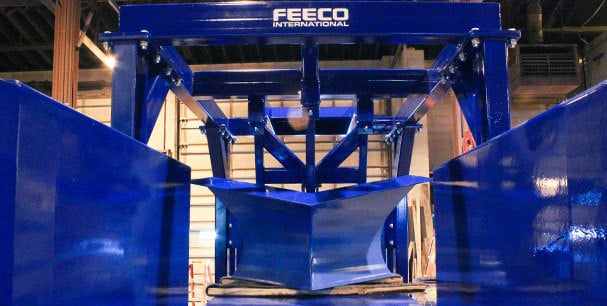
FEECO Belt Plow for fertilizer
Trippers and plows allow material to be discharged at strategic points along the conveyor, either from one or both sides, as well as at fixed or moving points.
The use of trippers or plows is ideal for filling multiple storage bins along the length of a conveyor, or for creating long, continuous piles in a bulk storage building.
Belt Feeders
Belt feeders are another crucial piece of equipment that improve fertilizer handling systems. The belt feeder allows material to be introduced to the system at a controlled rate from a bin or hopper, creating a consistent feed to the process.
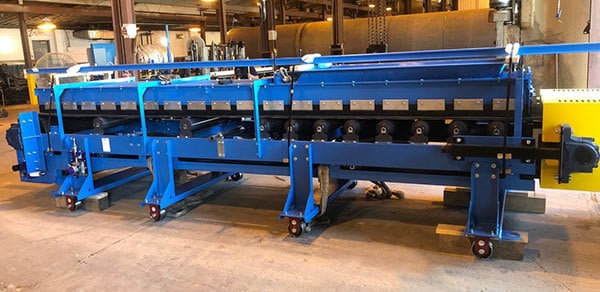
FEECO Belt Feeder
Handling Considerations When Working With Fertilizers
While handling concerns are largely site and material specific, there are common themes that run throughout the fertilizer industry.
Corrosion
Many fertilizer materials have corrosive qualities that if not designed for, could cause excessive premature wear on handling equipment. For example, corrosion is a frequent concern with potash, often requiring high-wear areas such as transfer chutes and inlet loading areas on conveyors to have wear-resistant liners or special materials of construction. Stainless steel and galvanized material are commonly employed as a way of combating corrosion.
Corrosion is also a frequent concern with organic materials, as these tend to have a higher moisture content.
Abrasion
Similarly, abrasion is a prevalent concern for many fertilizer operations, particularly on the mining and ore handling side. Bulk material handling equipment destined for this setting must be robustly constructed out of appropriate materials of construction and often require AR (abrasion-resistant) liners.
Dust
Dust is a concern in almost every bulk handling system, as it presents a number of issues that are not only a nuisance, but can also create a workplace hazard, as well as cause premature equipment failure.
To minimize the occurrence of dust, a number of customizations are typically included in the system. Depending on the form the material is in, and the level of dust prevention required, this might include integrated full-length skirt boards and exhaust ports at the loading end, as well as dust pick-off points over the discharge hood, and covers or gallery enclosures.
Dust minimization also plays into the handling system’s overall design; transfer points and drop heights must be carefully configured to diminish dust generation.
Buildup
As with any operation, preventing buildup is a primary objective in handling materials in the fertilizer industry. Material allowed to build up can increase the potential for corrosive wear, clogged or damaged equipment, increased maintenance time, as well as safety hazards. For this reason, routine inspections and cleaning are considered best practices. In cases where buildup is especially prevalent, dual belt cleaners are often incorporated to assist in this endeavor.
Moisture Content
Moisture content is a widespread concern for any handling application, as it plays a significant role in how a material responds to handling. Depending on the material, moisture content can vary significantly.
Materials with a high moisture content tend to present flowability challenges, sticking in chutes, clogging up conveyors, and more if not carefully managed. Materials of construction, as well as add-ons such as belt cleaners, are essential tools in managing high-moisture handling challenges.
New Handling Challenges
It’s worth noting that as the fertilizer industry continues to embrace the development and widespread use of specialty fertilizers, new handling challenges are being presented all the time. This trend underpins the need for a bulk material handling equipment manufacturer that can evaluate the unique needs of a system and address them through careful design and construction.
Conclusion
Belt conveyors, bucket elevators, trippers, plows, and feeders are used extensively throughout the fertilizer industry to handle fertilizer at every step of its life cycle, from raw ore to finished product. The unique challenges associated with fertilizers demands engineered system and equipment design to reach an efficient handling system that will perform reliably.
FEECO is known throughout the fertilizer industry for the best in custom fertilizer production and handling equipment. Each bulk solids handling system we design is designed around the specific goals and challenges of the site and material at hand. For more information on our custom material handling equipment, contact us today!



